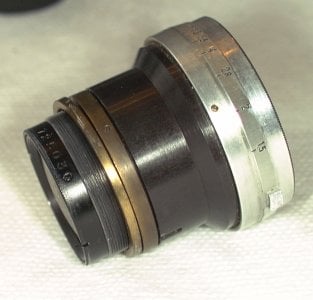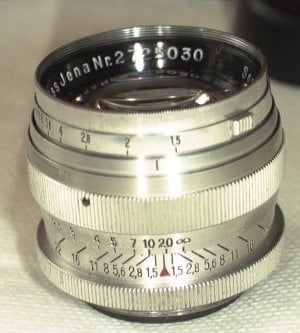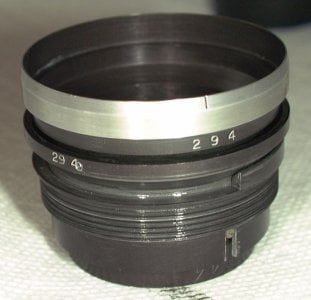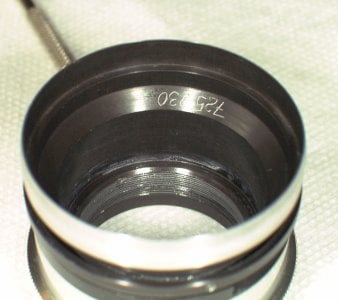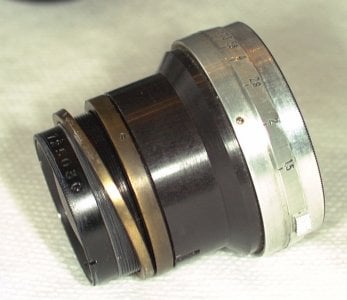boojum
Mentor
I forget the rest of the digits... remember "267", "272", "285", "175", "190", "255"...
OK, gotcha. It gets worse. ROTFLMAO
Now how about Herr Räuber? Is this "first three" your thing or standard at public level? I'd assume that if I communicated that 1942 CZJ 5cm he would want all the sn. This is almost as mysterious as a secret society rite. I am so naïve.
Last edited:
boojum
Mentor
Your fondness of the Bertele family that has been raised by the Zeiss family is well known. And there are some good "stepchildren" of the Bertele lineage who hail from further east, some from outside of Moscow (KMZ) and others in the FSU. If you had to select the finest of the f/1.5's and f/2.0's in the 5cm focal length, which would you choose? I know there are a lot of variables but on the basis of your experience and from your collection how do they place? For judging exclude the Skyllaney Bertele.
Curious on the Columbia.
Räuber
Established
This hints that the lens consist of parts from 2 different lenses. As I understand it the shorter internal number is just the index number of the lens within the batch. So this should be the 1052th (2.725.552) lens of the 58th production batch. But the serial stamped at the back is from the 2238th lens of the batch. It might even be that the internal block is not even from the 58th batch. It might belong to the 68th (2.845.301) batch instead where we see a lot of ZKs from 1949 already.
dexdog
Mentor
Rauber, I finally spent about an hour looking at your spreadsheets. Those represent a huge amount of work! Thanks for posting.
I'll post a few more. This is a late Wartime lens, the one that was so worn that it needed a sleeve made to stop wobble when focusing.This hints that the lens consist of parts from 2 different lenses. As I understand it the shorter internal number is just the index number of the lens within the batch. So this should be the 1052th (2.725.552) lens of the 58th production batch. But the serial stamped at the back is from the 2238th lens of the batch. It might even be that the internal block is not even from the 58th batch. It might belong to the 68th (2.845.301) batch instead where we see a lot of ZKs from 1949 already.
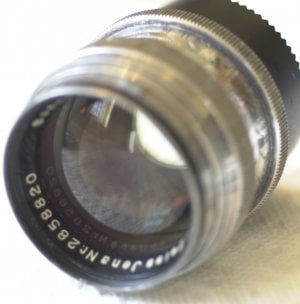
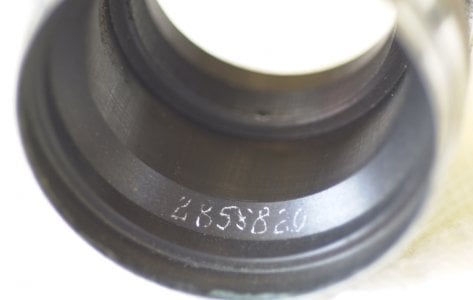
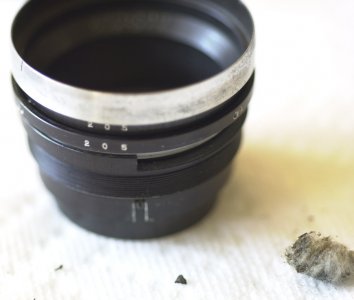
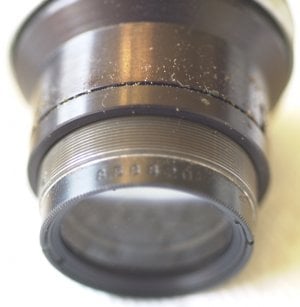
dexdog
Mentor
I just unscrewed my three 272 series f1.5 Sonnars in LTM to check for serials on inner helical.
- 2724915 has only last 3 digits, i.e., 915
- 2724921 has nothing
- 2725606 has nothing
Given that the first two are only 6 serial numbers apart and probably built close to the same time, it makes me wonder why some should be marked on inner helicals and others were not. Seems like everything about these lenses is designed to drive you crazy
Later edit: I unscrewed the 279 series f1.5 Sonnar and 280 series f1.5 R-Sonnar, they had no inner helical markings either. My 285 series f1.5 Sonnar that was serviced by Skyllaney last year was very tight in the mount, and I did not want to risk damaging it through the use of brute force and ignorance.
- 2724915 has only last 3 digits, i.e., 915
- 2724921 has nothing
- 2725606 has nothing
Given that the first two are only 6 serial numbers apart and probably built close to the same time, it makes me wonder why some should be marked on inner helicals and others were not. Seems like everything about these lenses is designed to drive you crazy
Later edit: I unscrewed the 279 series f1.5 Sonnar and 280 series f1.5 R-Sonnar, they had no inner helical markings either. My 285 series f1.5 Sonnar that was serviced by Skyllaney last year was very tight in the mount, and I did not want to risk damaging it through the use of brute force and ignorance.
Last edited:
Räuber
Established
I just unscrewed my three 272 series f1.5 Sonnars in LTM to check for serials on inner helical.
- 2724915 has only last 3 digits, i.e., 915
- 2724921 has nothing
- 2725606 has nothing
Given that the first two are only 6 serial numbers apart and probably built close to the same time, it makes me wonder why some should be marked on inner helicals and others were not. Seems like everything about these lenses is designed to drive you crazy
Absolutely! There seems to be no rule that is not broken by those Sonnar lenses. 😅
I have an example from the KEF Sonnar 1,5 batches (They can be unscrewed too).
- 5.942.692 with inner number 92
- 5.956.083 with inner number 13
However than I have the KEF Sonnars f2.
- 3.105.972 with inner number 386 (this lens looks strangely hacked)
- 3.502.222 with no inner number
- 3.753.987 with inner number 667 (the batch only contains 150 copies!)
The last example shows a strange numbering of this internal lenses numbers. It points to a batch start of 3.753.320 but the batch in the Fabrikationsbuch starts at 3.753.901 (it is the 86th lens). The serial 3.753.320 is not in conflict with any batch because there is a hole in the Fabrikationsbuch (not the only one) from 3.753.051 - 3.753.550 (500 lenses). But inbetween 3.753.320 and the real start of the KEF batch 3.753.901 are 2 Tessar and one Epiotar batches... So it can not be the 667th lens of any batch here.
Last edited:
Another wartime Sonnar that I CLA'd for a forum friend.
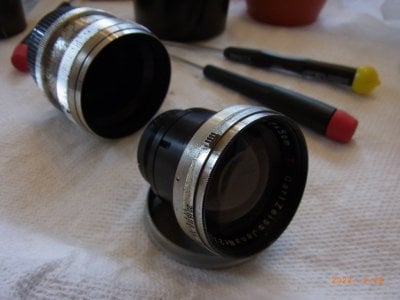
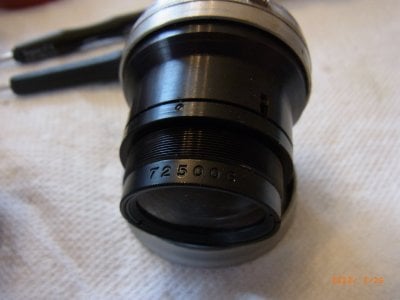
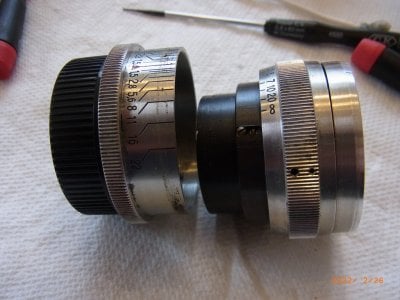
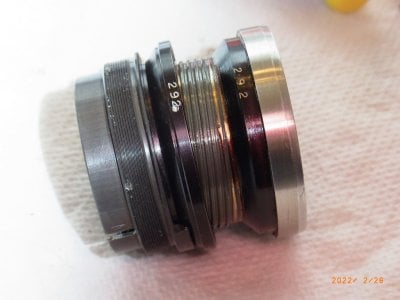
The SN on the focus parts are 2 from my 2725030 Sonnar, which is 294. This lens now resides in Australia.
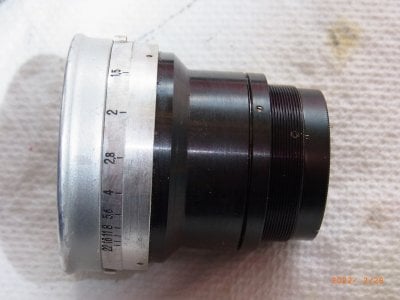
Always remember to look for hidden set screws on these lenses, one for the rear fixture and one for the namering. Not always there- but you will regret it if you forget to look!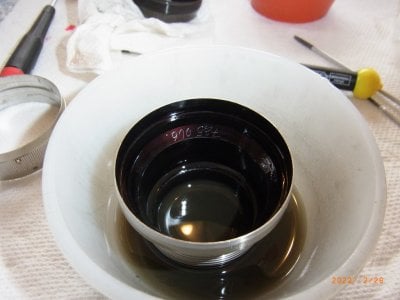




The SN on the focus parts are 2 from my 2725030 Sonnar, which is 294. This lens now resides in Australia.

Always remember to look for hidden set screws on these lenses, one for the rear fixture and one for the namering. Not always there- but you will regret it if you forget to look!

Last edited:
I recently picked up a pair of Sonnars without mounts or aperture rings. This inclused an early black/nickel mount. I'll have an easy time with the mount and aperture ring for the later 226x lens. The early one- I'll need to hack something. I need ~37mm inner thread ring, and will need a screw for the aperture linkage. The aperture linkage for the later lenses is too big to screw into the hole. I think a regular long set screw used to hold the barrel into the mount will work.
Two Sonnars with the same optical formula- different fixtures.
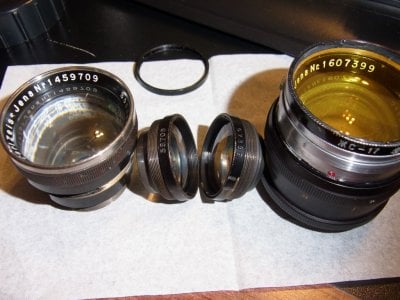
Rear glass is much shorted (~2mm) than later V3.
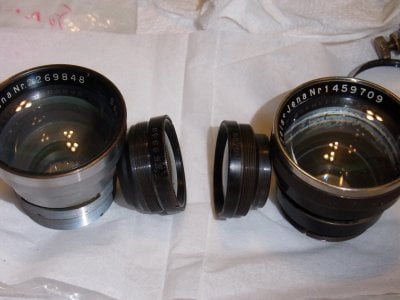
BUT- the early lens screws into a later mount, and can be used in the much later Carl Zeiss Opton mount!
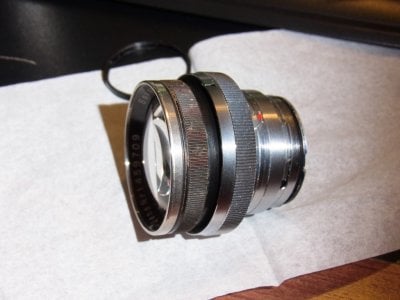
Two Sonnars with the same optical formula- different fixtures.

Rear glass is much shorted (~2mm) than later V3.

BUT- the early lens screws into a later mount, and can be used in the much later Carl Zeiss Opton mount!

I had to look- after seeing @Räuber list a Sonnar V3 prototype with a SN close to the first Sonnar that I converted to LTM, over 15 years ago. This one has a coated front element, I have seen one more from this batch just like it.
I pulled the rear fixture- it is the V3 type. It measures 2mm longer than the V2 rear fixture, and matches the later 226x Sonnar above. This fixture has spanner slots in the outer rim, unlike the older 1607x lens. The latter- spanner slots for the retaining ring for the glass, but not the fixture itself.
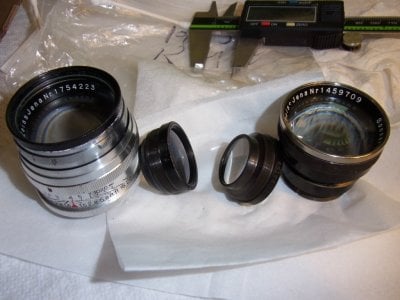
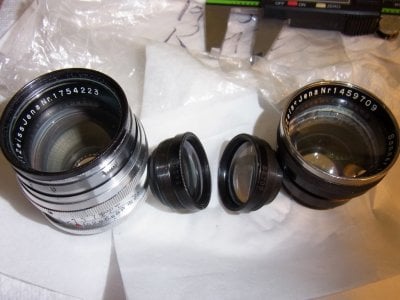
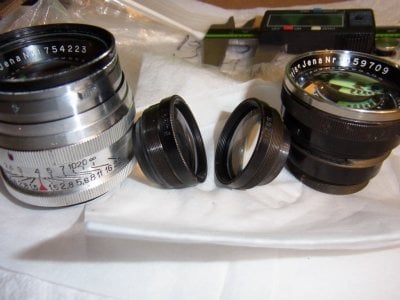
The Prototype Sonnar in this range is listed as having an equidistance aperture scale, and the V3 optics. My lens has the standard aperture scale to F11 and uses V3 optics.
One of my charry-picked favorites, focal length is very close to the Leica standard. Focus is sharp used wide-open from close-up to infinity.
I pulled the rear fixture- it is the V3 type. It measures 2mm longer than the V2 rear fixture, and matches the later 226x Sonnar above. This fixture has spanner slots in the outer rim, unlike the older 1607x lens. The latter- spanner slots for the retaining ring for the glass, but not the fixture itself.



The Prototype Sonnar in this range is listed as having an equidistance aperture scale, and the V3 optics. My lens has the standard aperture scale to F11 and uses V3 optics.
One of my charry-picked favorites, focal length is very close to the Leica standard. Focus is sharp used wide-open from close-up to infinity.
Last edited:
boojum
Mentor
What continues to amaze me about the Sonnars is that this is a very old lens design but it is still excellent. So many new lenses are computer designed and built and have marvelous optics, color accuracy and precision but are boring. And it is not just my crazy mind. People who make very expensive movies and sell them at great profit are chasing the retro lenses of the 40's and 50's for their "character" for want of a better world. In my limited experience I have a few retro's. The wonderful Skyllaney Bertele Sonnar, a nice CZJ '42 Sonnar f/1.5, some KMZ J8's, a nice Cooke Amotal and a couple others and they are all good lenses for pictures. I am not engraving anything.
The Bertele Sonnar design has been copied and aped by many manufacturers just because it is so good. And while I have never used a Leica lens I do not feel I have missed anything when I shoot with my retros. They soothe the digital sensor. There are some excellent seminars on this board if you search them out.
The Bertele Sonnar design has been copied and aped by many manufacturers just because it is so good. And while I have never used a Leica lens I do not feel I have missed anything when I shoot with my retros. They soothe the digital sensor. There are some excellent seminars on this board if you search them out.
I've taken apart a few post-war West German 50mm Sonnars, and "mentally noted" that there were design changes made to the fixtures and barrels. True of the 50mm F1.5 and 50mm F2. I also remember that there was not a clean break based on Serial number. With @Räuber mentioning that there was a change to the optical formula of the 50mm f1.5, I dug out my parts lenses for direct comparison.
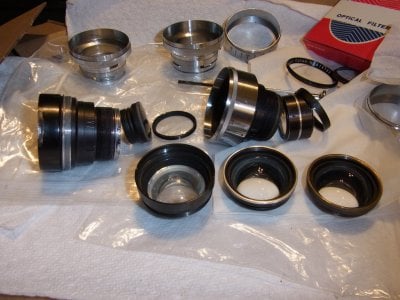
The earlier design uses separate fixtures for the front element, middle triplet, and rear triplet: reminds me of the CZJ 5cm F2 pre-war version, where the front element and middle triplet are stamped in brass fixtures. The post-war fixtures use retaining rings, that are cemented in place. I had to cut through the retaining ring on the front fixture to get the very-bad glass out.
The later version has a fixture where the middle triplet and front element fit in, and are held in by retaining rings- more like a Jupiter-8.
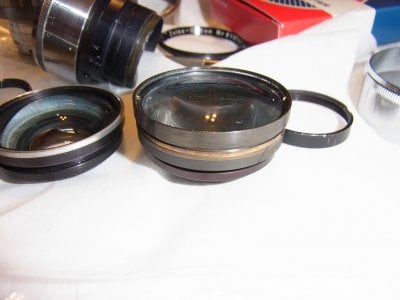
I did a quick test for the radius of the glass. A 1953 KMZ front element fit perfectly into the earlier fixture. This element is interchangeable with the v4 Sonnar. It was slightly too small for the later fixture. The back of the middle triplet of the earlier lens has a smaller diameter than the later lens. As I get more time, will do some more measurements. BUT: I believe the optical formula changed with the later Sonnar, and the barrel design changed for the new optical design.
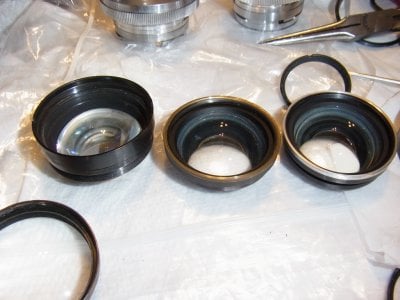
Two of the earlier fixtures for the middle triplet: design changed for those as well.
The Namering has been changed, note the thickness.
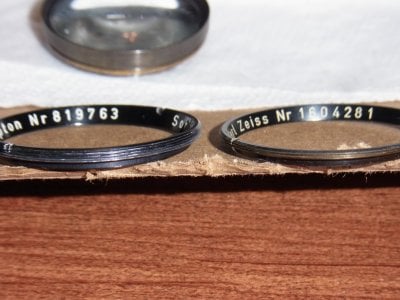
Why? With the Japanese producing the Nikkor-SC 5cm F1.5 and F1.4, Carl Zeiss Jena producing the 5cm F1.5, and USSR producing the Jupiter-3: I believe Carl Zeiss wanted to up their game. I've seen this in performance of various West-German Sonnar 50/1.5's when using them: some are "just better". Sadly: the cement used in them does not hold up as well as the earlier versions.
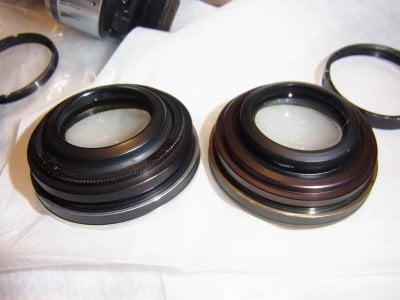
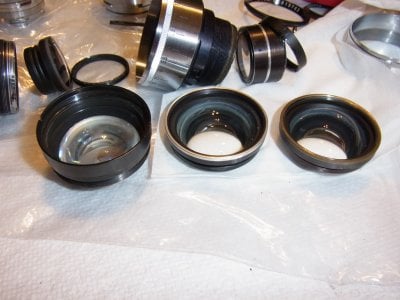
And the cement on the later version, left, has failed.
Say it in Pictures!

The earlier design uses separate fixtures for the front element, middle triplet, and rear triplet: reminds me of the CZJ 5cm F2 pre-war version, where the front element and middle triplet are stamped in brass fixtures. The post-war fixtures use retaining rings, that are cemented in place. I had to cut through the retaining ring on the front fixture to get the very-bad glass out.
The later version has a fixture where the middle triplet and front element fit in, and are held in by retaining rings- more like a Jupiter-8.

I did a quick test for the radius of the glass. A 1953 KMZ front element fit perfectly into the earlier fixture. This element is interchangeable with the v4 Sonnar. It was slightly too small for the later fixture. The back of the middle triplet of the earlier lens has a smaller diameter than the later lens. As I get more time, will do some more measurements. BUT: I believe the optical formula changed with the later Sonnar, and the barrel design changed for the new optical design.

Two of the earlier fixtures for the middle triplet: design changed for those as well.
The Namering has been changed, note the thickness.

Why? With the Japanese producing the Nikkor-SC 5cm F1.5 and F1.4, Carl Zeiss Jena producing the 5cm F1.5, and USSR producing the Jupiter-3: I believe Carl Zeiss wanted to up their game. I've seen this in performance of various West-German Sonnar 50/1.5's when using them: some are "just better". Sadly: the cement used in them does not hold up as well as the earlier versions.


And the cement on the later version, left, has failed.
Say it in Pictures!
milescl
Well-known
Räuber
Established
@Räuber Are you working on an overview of all f2 lenses?
Yes. Not very active at this moment. I'm still in the process of collecting but have measurements of 43 5cm f/2 lenses. Sounds like I should speed up and start writing.
Another topic. Has anybody a copy of the book from John Keesing "Contax Ragefinder Lenses 1932 - 1962" flying around? I would really like to compare his list of variations with mine.
VINTAGE CONTAX RANGEFINDER LENSES 1932-1962 COMPILED BY JOHN KEESING | #1943996468
VINTAGE CONTAX RANGEFINDER LENSES 1932-1962 COMPILED BY JOHN KEESING ON MAY 2000.31 PAGES. VERY GOOD CONDITION. ENJOY!!!(CABINET 2, SHELF 1)
Last edited:
dexdog
Mentor
Rauber, I have a copy of John Keesing's booklet.Another topic. Has anybody a copy of the book from John Keesing "Contax Ragefinder Lenses 1932 - 1962" flying around? I would really like to compare his list of variations with mine.

VINTAGE CONTAX RANGEFINDER LENSES 1932-1962 COMPILED BY JOHN KEESING | #1943996468
VINTAGE CONTAX RANGEFINDER LENSES 1932-1962 COMPILED BY JOHN KEESING ON MAY 2000.31 PAGES. VERY GOOD CONDITION. ENJOY!!!(CABINET 2, SHELF 1)www.worthpoint.com
p.giannakis
Pan Giannakis
Is there something you can do about that? I have a Nikkor that started delaminating.And the cement on the later version, left, has failed.
A few shops will have the elements recemented- which is not cheap.Is there something you can do about that? I have a Nikkor that started delaminating.
Over 15 years ago- I had a Canon 135/3.5 LTM that had the cement fail. I cleaned the surfaces and used a small drop of index matching gel between them. The fixture was good enough to align the elements, and retaining ring hold them in place and squeezing them tight together. No Newton's rings, no bubbles. 15+ years later- still good.
Räuber
Established
I updated the spreadsheet with the collected Sonnar 5cm F1,5 variations with measurements of the f8+ and LTM wartime Sonnar.
And I did something dangerous and stupid. I measured the diameter of the glass pupils of all my lenses. Imagine how I try to measure the diameter of a glass lens with a caliper... Yes, I did it. 🙈 You can find the diameter of the front and rear lens in the table. Unfortunately I have no example of the very first Sonnars (f8).
It was quite interesting to compare the numbers when finished. You can see some changes of optical construction. Not all changes match the calculations of Bertele.
- the diameters of the first f8 Sonnars with Berteles first calculation are missing (v1)
- the numbers hint that at least the last f8+ Sonnars use the second calculation since the numbers of the f11 and f8+ Sonnars are pretty equal (v2; 35mm; 25mm)
- interestingly the black band Sonnar has a smaller front pupil than the f11 Sonnar but both lenses should share the same calculation (v2; 34.3mm; 25mm)
- shortly after the black band Sonnar a all chrome version was build, and while it uses the smaller front pupil too the rear pupil got smaller too, it uses a new computation from Bertele though (v3; 34.3mm; 24mm )
- then there is a another small cosmetic change of the all Chrome barrel when the rear part get more blocky, this time the front pupil gets a little bit wider, but there is no new calculation from Bertele at this time (v3; 34.5mm; 24mm)
- when Berteles 4th calculation is introduced into production in 1939 there is no noticeable change of the diameters (v4; 34,5mm; 24mm)
- post-war the diameters where changed by Carl Zeiss Jena quite drastically, but the calculation is still the same as before the war (v4; 34.85mm; 22mm)
- Zeiss Oberkochen got a new computation from Bertele for their Opton-Sonnar, the new lens uses a wide front glass (v5; 35.25mm; 24mm)
- Zeiss Oberkochen reduced the diameter of the front pupil when switching to the black rim version of the Opton-Sonnar, same calculation as before (v5; 34.9mm; 24mm)
- the later Carl Zeiss Sonnar uses a smaller front pupil, no changes of the calculation so far we know (v5; 34.5mm; 24mm)
- the last recalculation from 2006 uses a very wide front pupil and a small rear pupil (v6; 36mm; 22mm)
- the Soviets used the same diameters as the wartime Sonnars but they had a own computation (v4z; 34.5mm; 24mm)
- the Jupiter 3+ from 2014 has a tiny bit wider front diameter (v4z; 34.6mm; 24mm)
The changes made to the post-war East German CZJ Sonnar are interesting too. The front pupil got wider but the rear significant smaller. Mr. Thiele does not mention a new calculation though. Another proof that calculation and those diameters can change independently.
Share:
-
This site uses cookies to help personalise content, tailor your experience and to keep you logged in if you register.
By continuing to use this site, you are consenting to our use of cookies.





